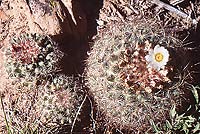If you’ve visited the Sonoran Desert in places like Saguaro National Monument or Organ Pipe Cactus National Monument, then you’ve seen desert cacti at their finest. Tall and graceful saguaros with animated limbs or barrel-shaped cacti the size of fire hydrants, these plants define that desert region.
Fortunately, throughout the west, even up in the Pacific Northwest, explorers can locate cacti and enjoy these classic desert plants. 
The most abundant cacti in the Canyon Country are the prickly pears. Several different species grow here, but their basic form with flattened pads jointed together is the same. Long, straight spines arise from a point surrounded by smaller spines that easily break off and can form a pestering wound should one have a “close encounter of the spine kind.”
During periods of drought, a prickly pear cactus may drop some of their outer pads. This minimizes moisture needs and helps the plant survive. If conditions improve, these dropped-off pads may sprout roots.
Prickly pear cacti flowers range in color from yellow to pink to red. Looking into the deep, wide flowers, one might observe a variety of beetles, flies, bees, and other insects mowing through a field of pollen-bearing stamens. Researchers have determined that the bees are the best at pollination; the beetles are there mostly to eat pollen. One of the cool aspects of the stamens is that they respond to touch. As an insect moves around inside the flower, the stamens close in towards the center. This may be an adaptation to enhance cross pollination or to assist with self-pollination.
The flower petals of the prickly pears have a waxy quality, and the blooms a sweet fragrance to attract pollinators. After pollination and when the fruits form, they are reddish pulpy cylinders covered with small spines. Native Americans and folks today harvest these fruits. The spines are burned or sliced off and the mashed fruits eaten or made into cactus jelly.
Occasionally, a white cottony mass forms on the prickly pear pads as the result of a scale insect, known as the cochineal bug. These creatures were harvested by the Mixtec Indians of pre-Hispanic Mexico and crushed into a red dye. The bugs have carmic acid in their systems to ward off predators, but this same product yields a scarlet or crimson color when crushed. Used to dye cloth, modern-day weavers can still order bags of cochineal bugs for dyeing fabric. And if you check some food labels, you might find “cochineal extract” as one of the ingredients.
Barrel-shaped cacti are also found in the region. One species is the hedgehog cactus, named for its small spines resembling those of the spiny mammal. These cacti may grow as a single stem or form clumps that barely rise above the ground. They bear striking reddish flowers in early spring and are a photographer’s delight when found set against a colorful backdrop of sandstone.
Another small barrel-shaped cactus is the Whipple’s fishhook. This cactus bears fishhook-shaped spines and a light purplish flower. The common name honors Lt. Amiel Wicks Whipple (1818-1863), a topographical engineer who served on the boundary survey between the United States and Mexico from 1853-1856.
Found at higher elevations in the La Sal Mountains, the pincushion-like Simpson’s pediocactus is a half-domed sized, low-growing cactus that bears small whitish (sometimes purple or yellowish) flowers. This cactus grows in rocky soils in mountain ranges throughout the West, sometimes found at elevations above 11,000’.
Named after James H. Simpson (1813-1883), another topographical engineer who first collected it in Nevada. Cold hardy, horticulturally-grown plants survive well in many northern climate gardens. But please remember to not harvest cacti from the wild, and let others enjoy these special plants that thrive in Canyon Country..


